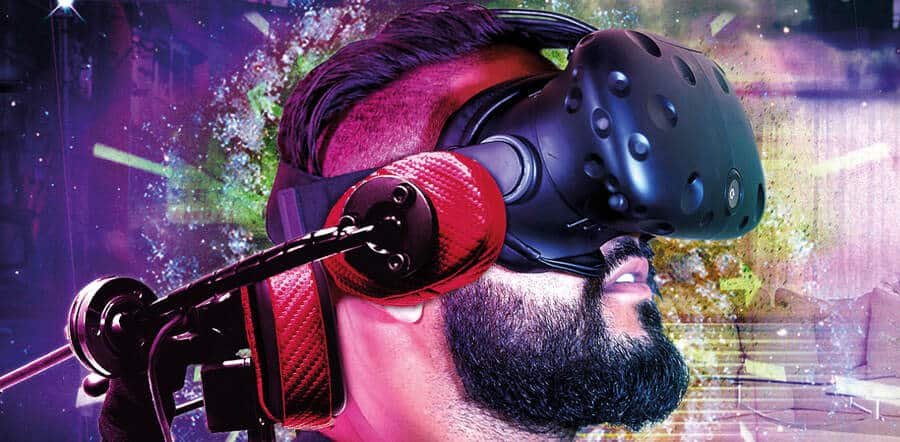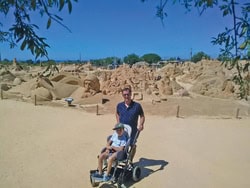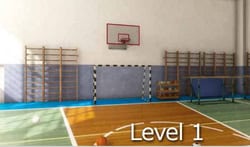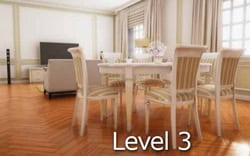Let’s Get It Clear: Are they safe to drive a powered wheelchair?

People have been denied a powered wheelchair because it has been considered they might not be safe to use one. But whose safety has been the prime consideration? The driver – or the people and the environment around the chair? In this article we look at means to provide people with the skills deemed necessary for safe use of a powered wheelchair so that everyone and their surroundings are better protected, and the occupant can happily lead a more independent life.
At a conference in September 2023 in Leiria in Portugal, an OT, João Aires with his colleague Ádner Silva, presented a case study of Bernardo, an intelligent young man with cerebral palsy, who was living a life of being pushed around in a wheelchair (Figure 1).

He and his parents wished that he be issued with a powered wheelchair so that he could start living an independent and freer lifestyle. He went along for an assessment at a local centre and was placed in an electric wheelchair, and asked to drive it along a corridor. But when he came to a corner he was unable to get round it successfully at the first attempt, and on that basis alone the prescription was denied!
How often have heard this story around the world. The good news is that, with perseverance, Bernardo now has his powered mobility, and driving it skilfully (Figure 2). The disappointment of the original refusal could have been avoided if Bernardo had been given the chance to have developed the required driving skills before the assessment.
Learning to drive
As we learn spatial awareness from early childhood we start crawling backwards before forwards. We totter and fall into things as we learn to walk. However, for those who have restricted mobility in early life, the only way they could develop spatial awareness would be by using a powered wheelchair. And often these individuals too will start by driving backwards. A powered wheelchair can also be the only means by which they have a chance to learn to play – and also be mischievous and express themselves fully.

So, how can we learn to drive a wheelchair safely? Airline pilots are not expected to get behind the controls of a plane and fly passengers around until they have learned to fly that type of plane. The way they learn is through a flight simulator. The good news is that wheelchair ‘flight simulators’ (i.e. driving simulators) are also available these days for aspiring powered wheelchair users.
Alternative controls
Powered wheelchairs are controlled as standard by a joystick, and this can be positioned not only for hand use, but also for chin or foot use.
However, there are some people with some neurological disorders who do not have the fine motor control to be able to control a joystick, but switch arrays behind the head or set in trays, for example, can provide an alternative means to drive the chair, e.g. one switch for straight, another for left, and a third for right.
The use of ‘proximity’ switches allows speed control: the nearer the switch, the faster the travel. Adding in modern computer technology means that the signals from each of the switches can be processed to achieve smooth and instinctive fine changes of direction when driving a chair. The Stealth i-Drive® system1 is an example that achieves this by a computer capable of processing tens of thousands of signals a second.
Computer gaming
We now have the means to drive a chair, whatever the impairment, for example by small movements of the head, or a finger. The next challenge is what can be used to learn how to use these control systems accurately.
One fun means is the i-Drive® Loonz™ game2 (Figure 3). This is a computer game downloadable from the App Store for use on an iPad or iPhone, and which can be played using a joystick or alternative switches, and


fine tunes the user’s motor skills while the user is having fun picking up ‘rewards’ while moving from level to level.
Virtual Reality (VR) Driving Simulator
The next stage of progression is moving from the two-dimensional world of gaming to the three-dimensional world of real life. This is where the i-Drive® VR Driving Simulator package comes in (Figure 4). This links controls connected to an i-Drive Assessment Interface to a VR headset (Figure 5).


The program offers three levels of skill and real-life simulation.
The first level takes place in a large virtual gymnasium with few distractions and obstacles (Figure 6). This level allows the driver to accommodate to the VR experience and begin simple powered wheelchair movements. The driver can progress to tasks with cones, driving between lines, and turning.
The second level takes place outdoors where the driver can explore safely the environment of a quiet wooded trail. (Figure 7) This level provides a sense of movement over varied terrain.
The third level provides a more closed area experience, simulating the challenges found in a home (Figure 8). The driver navigates through rooms, hallways, and between furniture. The driver can also practice positioning a power wheelchair close to objects which are commonly transferred to from a wheelchair. This final level presents more challenging tasks and distractions, as well as changes in speed, lighting, spatial perception, distance, and sound.

The future is here
Powered mobility provides the means for mobility-impaired individuals to have a better quality of life. Modern alternatives for controlling a wheelchair mean that even those with the most severe impairment have a means to drive a chair (and use the same switches to control their environment), and current powerful computing means that the driving can be both intuitive and smooth.
Cutting-edge computing also means that the tools are now available to train users through games and simulators so that the user is ‘good to fly’ as soon as they have delivery of their powerchair. These advancements should make the safe provision of powered wheelchairs possible for a wider variety of users enabling them to experience greater freedoms and more rewarding lives.
References
- Alternate controls and i-Drive: https://idrive.stealthproducts.com/
- i-Drive® Loonz™ game: https://idriveloonz.stealthproducts.com/
- Virtual Reality Driving Simulator: https://stealthproducts.com/pdfs/2020/bro_i-Drive–VR.pdf
- Further information from UK contact: BES Healthcare Ltd info@beshealthcare.net


